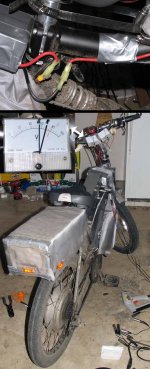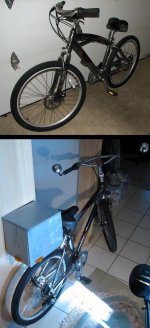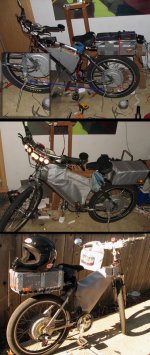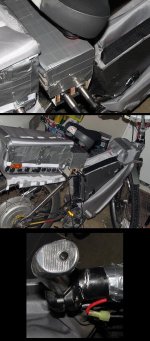Just got back from a short test ride. Worked as expected. The box does not hit my thighs, though it might if I keep biking and buildup big huge quads

I'll get some hard comparison data as far as acceleration, and speed@amps after I get that spoke fixed and charge the pack fully.
Your total disregard for the conventions of "safety" is having an effect. Rather than me being worried about Lithium batteries the lack of fear you demonstrate tends to make me also want to "risk it" and build a pack without all the PCB's and crap that makes the things overly expensive and complicated.
I have great regard for the conventions of safety, but I've done enough study I think of lithium batteries to better appreciate what constitutes end-user protecting tech, and what constitutes vendor protecting tech (from lawsuits by non-diligent users). Patrick Mahoney has a pack of the same cells configured 12s8p and doesn't use a BMS either. His fancy RC charger balances the subpacks of parallel-wired cells during charge as I do with cheaper, multiple chargers.
Do me a favor and create a new "technical thread" and just walk through category, by category all the areas that you need to watch out for and also what is "overhyped" as a fear. (when you are done with your ride of course)
Do me a favor and read up and study about lithium batteries like I did, then as you have specific questions, post them to the tech thread and I'd be happy to give my 2 cents along with everyone else.
What about, a dum-charger? (Dum= no automatic cut off, no lights, just DC current).
One that would mimic a fully charged battery. One that would give constant 4.2v from the beginning, until you unplug it, like a fully charged battery that never runs out of juice.
That's basically what my batteryspace chargers are. Plug'em in and with a DVM they measure about 4.2v (range 4.15 - 4.2). Fechter would know more, but since each puts out no more than 4.2v, I don't think it can overcharge lithium batteries -- the current slows to zero as the battery voltages approaches the charger voltage (there is no electromotive force when the voltages are equal to shove in any more amps).
Would it charge the other batteries, therefore the whole pack?
If you wanted to charge the whole pack with one charger, then your charger would have to 4.2v times however many llithium cells in series you have. In my case that'd be 84 volts. But the problem there is each subpack in series will not balance with the other subpacks in series (though the cells within each subpack, because they're wired in parallel with each other, will balance each other within a subpack) so you'll end up with one subpack at a significantly lower voltage then the others, and while total voltage will look OK on a voltmeter measuring the entire pack's voltage, one or more subpacks (of cells wired in parallel) will begin to overdischarge.
Because, if one battery has more juice than the others in a pack, it will give its juice to the others, right?
For lithium and lead-acid in parallel, yes. For nicad/nimh, the situation is more complicated. But lithium and lead and every other chemistry I'm aware of will not balance in series, that's why those powercheq devices for lead batteries are popular, and why lithium RC chargers have battery balancing functions, and why good BMS's also balance batteries in series during discharge.
Balancing during discharge is slightly better, but much more expensive and/or complicated to wire. Balancing during charging as I do is good enough for me because the difference at the end of a ride between subpack's voltage is very small, like 0.02 volts or less, and gets equalized whenever I recharge.
[/quote]








